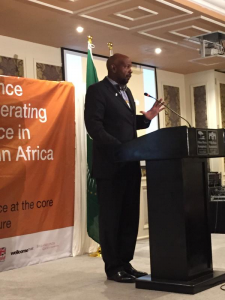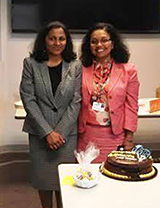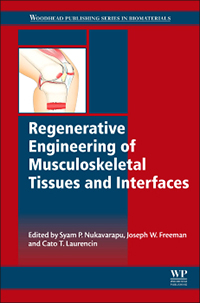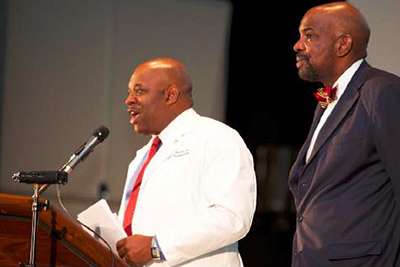 In March, 2015, the African Union supported the establishment of the Alliance for Accelerating Excellence in Science in Africa (AESA) under the leadership of the African Academy of Sciences and the New Partnership for Africa’s Development. AESA will help drive Africa’s research agenda and build scientific capacity across the continent. The Wellcome Trust, the Bill and Melinda Gates Foundation, and the UK Department for International Development are funding the development of AESA and sharing their vision of supporting the next generation of African researchers who will help solve some of the continent’s greatest health and development challenges.
In March, 2015, the African Union supported the establishment of the Alliance for Accelerating Excellence in Science in Africa (AESA) under the leadership of the African Academy of Sciences and the New Partnership for Africa’s Development. AESA will help drive Africa’s research agenda and build scientific capacity across the continent. The Wellcome Trust, the Bill and Melinda Gates Foundation, and the UK Department for International Development are funding the development of AESA and sharing their vision of supporting the next generation of African researchers who will help solve some of the continent’s greatest health and development challenges.
In early September, I was honored to receive an invitation to attend the AESA launch in Nairobi. I delivered a speech during which I read a letter from Dr. Francis Collins, the Director of NIH, in support of AESA. As a African-American, I am very proud Africa will play a key role in building a world-class scientific and programmatic unit.
 Congratulations to IRE student Aiswaria, who successfully defended her master’s thesis on August 6, 2015. Her work was titled “Evaluation of biodegradability and cell functionality of injectable glycol chitosan hydrogel.”
Congratulations to IRE student Aiswaria, who successfully defended her master’s thesis on August 6, 2015. Her work was titled “Evaluation of biodegradability and cell functionality of injectable glycol chitosan hydrogel.” On August 5, Eric N. James, a member of the Institute for Regenerative Engineering, successfully defended his Ph.D. thesis, “Post-Transcriptional Regulation in Osteoblast Using Localized Delivery of microRNAs from Nanofibers.” Eric wrote his thesis under the supervision of Dr. Lakshmi S. Nair as part of Skeletal, Craniofacial and Oral Biology Graduate Program. Members of his committee also included Drs. Anne Delany and Yusuf Khan.
On August 5, Eric N. James, a member of the Institute for Regenerative Engineering, successfully defended his Ph.D. thesis, “Post-Transcriptional Regulation in Osteoblast Using Localized Delivery of microRNAs from Nanofibers.” Eric wrote his thesis under the supervision of Dr. Lakshmi S. Nair as part of Skeletal, Craniofacial and Oral Biology Graduate Program. Members of his committee also included Drs. Anne Delany and Yusuf Khan. The Institute for Regenerative Engineering recently published a new textbook, Regenerative Engineering of Musculoskeletal Tissues and Interfaces. Published by Woodhead Publishing Ltd, this comprehensive book looks at individual musculoskeletal tissues as well as tissue interfaces. Early chapters cover various fundamentals of biomaterials and scaffolds, types of cells, growth factors, and mechanical forces, moving on to discuss tissue-engineering strategies for bone, tendon, ligament, cartilage, meniscus, and muscle, as well as progress and advances in tissue vascularization and nerve innervation of the individual tissues. Late chapters present information on musculoskeletal tissue interfaces. As the chief editor, I want to express my gratitude first and foremost to all our contributors and especially, my co-editors, Drs. Joseph Freeman and Syam Nukavarapu, for their tireless efforts and time to edit this book.
The Institute for Regenerative Engineering recently published a new textbook, Regenerative Engineering of Musculoskeletal Tissues and Interfaces. Published by Woodhead Publishing Ltd, this comprehensive book looks at individual musculoskeletal tissues as well as tissue interfaces. Early chapters cover various fundamentals of biomaterials and scaffolds, types of cells, growth factors, and mechanical forces, moving on to discuss tissue-engineering strategies for bone, tendon, ligament, cartilage, meniscus, and muscle, as well as progress and advances in tissue vascularization and nerve innervation of the individual tissues. Late chapters present information on musculoskeletal tissue interfaces. As the chief editor, I want to express my gratitude first and foremost to all our contributors and especially, my co-editors, Drs. Joseph Freeman and Syam Nukavarapu, for their tireless efforts and time to edit this book. On April 10th, Paiyz Mikael successfully defended her Ph.D. thesis and completed her work with the Institute for Regenerative Engineering. Paiyz joined the Institute under the guidance of Dr. Syam Nukavarapu as part of UConn’s Biomedical Engineering Program. Her thesis focused on developing mechanically superior polymeric-carbon nanotube composite scaffolds for the regeneration of segmental bone defects.
On April 10th, Paiyz Mikael successfully defended her Ph.D. thesis and completed her work with the Institute for Regenerative Engineering. Paiyz joined the Institute under the guidance of Dr. Syam Nukavarapu as part of UConn’s Biomedical Engineering Program. Her thesis focused on developing mechanically superior polymeric-carbon nanotube composite scaffolds for the regeneration of segmental bone defects. On March 6th, UConn Health hosted the second Women in Surgery Lectureship with guest lecturer Dr. Andrea Hayes-Jordan, Director of Pediatric Surgical Oncology and Associate Professor of Surgical Oncology and Pediatrics at University of Texas MD Anderson Cancer Center. The lectureship, co-sponsored by CICATS and the Department of Surgery, was moderated by Dr. Linda Barry, CICATS COO and Assistant Director.
On March 6th, UConn Health hosted the second Women in Surgery Lectureship with guest lecturer Dr. Andrea Hayes-Jordan, Director of Pediatric Surgical Oncology and Associate Professor of Surgical Oncology and Pediatrics at University of Texas MD Anderson Cancer Center. The lectureship, co-sponsored by CICATS and the Department of Surgery, was moderated by Dr. Linda Barry, CICATS COO and Assistant Director.
